[dropcap]I[/dropcap]n Cambodia, corruption has the characteristic of being democratic: It spreads from the front-desk clerk to the department head. One ends up paying just to get one’s right to it,” writes researcher Julien Cheverny.
“When trading influence goes together with the power to sell, it’s corruption that makes it possible to set the actual hierarchy in public administration jobs,” he writes. “Naked greed involves little risk and leaves no unfortunate accounting evidence. Favors come from above, gifts from below.”
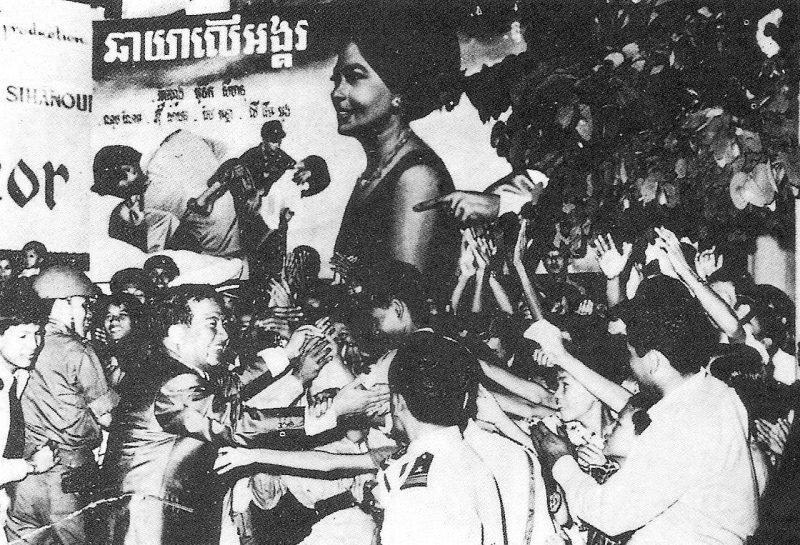
This analysis, apt in describing the ruling CPP’s deep-rooted patronage network, appeared 45 years ago in Mr. Cheverny’s 1971 book, “Eloge du colonialisme, or “In Praise of Colonialism,” as he traced corruption and influence peddling in the country during the 1960s, when Prince Norodom Sihanouk ruled Cambodia.
Many Cambodians who lived through the war and conflicts that turned the 1970s and ‘80s into a living nightmare would hang on to the memory of Prince Sihanouk’s time in power as a golden era. They remembered the good in his regime—the brilliant architects, filmmakers and artists that transformed Phnom Penh into one of the most vibrant capitals of the region—and ignored the rest.
In a marked contrast to his son, King Norodom Sihamoni, King Sihanouk is also fondly remembered for being a mediator and voice of reason during the 1990s and early 2000s, calling opponents to negotiate during times of crisis or at least speaking out from his throne amid tumult, even if this meant profusely apologizing to Prime Minister Hun Sen the following day.
By the time he died in October 2012, the days of the monarch as the national peacemaker and voice of moral authority had ended. The most brutal aspects of his rule have largely been left to the footnotes of history, but its excesses continue to be emulated by those running the country today.
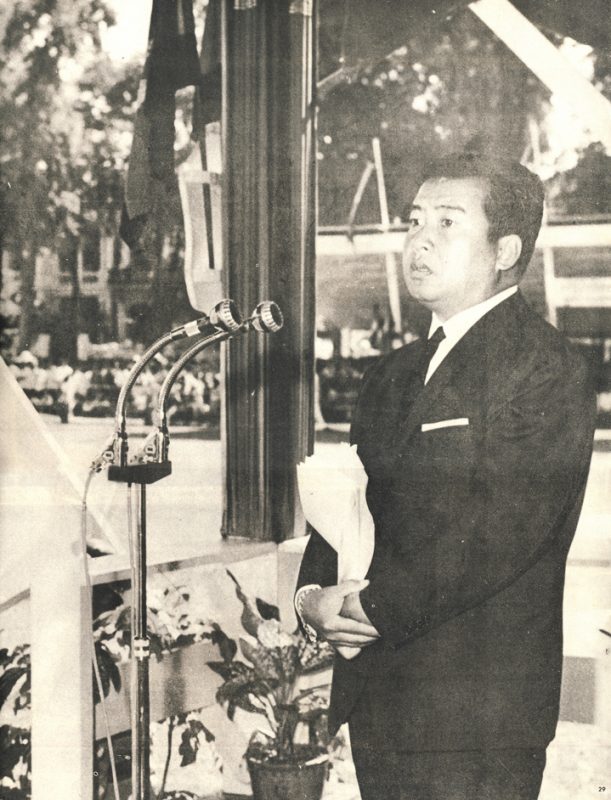
[dropcap]I[/dropcap]t was a wiser King Sihanouk who emerged in the 1990s, no longer hopeful of holding the reins of power himself, but still eager to be involved in politics and wishing to help the country heal. While many would criticize his actions, his love for Cambodia and its people was unquestioned.
This was not the young man who four decades earlier had stepped down from the throne in order to formally enter politics and take absolute and sometimes bloody control of the country.
In the 1950s and ’60s, Prince Sihanouk crushed all opposition and imposed ruthless controls on information, sending many of the country’s most promising youth into hiding in fear for their lives and causing others to join a communist movement that would become the Khmer Rouge.
Prince Sihanouk did not believe in democracy.
“We believed that there should be another path for developing countries, a mandatory phase with a single party and dictatorship,” he said during an interview in 1993, speaking about himself and other Southeast Asian rulers of that era.
Now that he was older, he added, “I believe that it’s possible to educate people and make them grasp universal values.”
A descendant of kings who had ruled with absolute power for more than a millennium, the prince was slow to adapt. In the wake of World War II, Cambodians were already showing the world that they were grasping those universal values and were ready for a democratic system.
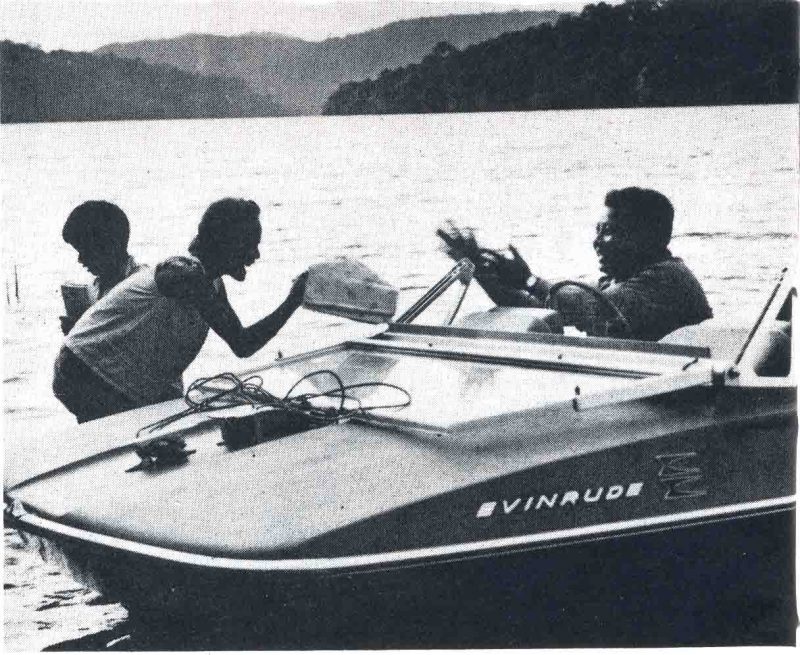
On September 1, 1946—70 years ago this month—Cambodians went to the polls for the first time in history to choose a leader in a democratic-style election. By an absolute majority, the people elected the Democratic Party, headed by the highly respected and progressive Prince Sisowath Yutevong.
This took many by surprise.
Cambodia at the time was under French administration as part of Indochina, which also included Vietnam and Laos. That the Democratic Party advocated the country’s independence did not endear it to the French.
When the party adopted a new constitution in 1947 that established Cambodia as a constitutional monarchy—as it is today—with a king who reigns but does not rule, 24-year-old King Sihanouk was far from pleased.
Prince Yutevong died of illness in 1947, but the Democratic Party again won an absolute majority in the December 1947 elections.
So King Sihanouk took matters into his own hands.
With the support of the French, he postponed the 1949 national election, dissolved the National Assembly and named himself head of the government in September 1949. A few months afterward, Ieu Koeus, leader of the Democratic Party and president of the National Assembly, was assassinated. Two years later, King Sihanouk dismissed the Democratic Party government and assumed power.

In 1955, he would abdicate, place his father King Norodom Suramarit on the throne and officially enter politics at the head of his own political party, which would give its name to that era in Cambodia: the Sangkum Reastr Niyum, or People’s Socialist Community.
A last attempt at a political system with an opposition would be crushed in August 1957 when, following a radio debate between Prince Sihanouk and Democratic Party leaders at the Royal Palace, palace guards attacked and injured the prince’s foes. Over the next three days, Democratic Party supporters were hunted and beaten, marking the violent end of the multi-party system.
“We will never know how closely [Prince] Sihanouk was involved in authorizing many of the individual cases of intimidation, torture and assassination carried out by his secret police,” historian Milton Osborne writes in his book “Sihanouk: Prince of Light, Prince of Darkness.”
“But it is clear that he was not distressed by such incidents as the killing of the editor of the communist front newspaper Pracheachon in Phnom Penh in October 1959…he clearly approved the decision to jail left-wing journalists and suppress their newspapers in August [1960], when they criticized his educational policies.”
In September 1967, all non-state newspapers were banned, leaving only publications from the Ministry of Information. The population was left with one source of information: Prince Sihanouk and his loyalists.
Fear filled those known to not fully endorse the system. One Cambodian who lived in Phnom Penh at the time remembers government officials being petrified by the launch of a publication used by Prince Sihanouk to scold those whose policies or actions had his disfavor. Criticism in that publication could mean dismissal, if not worse.
The person still shivers at the memory of going to a movie theater in the 1960s and being shown, prior to the main feature, the newsreel of an execution of an opponent of Prince Sihanouk.
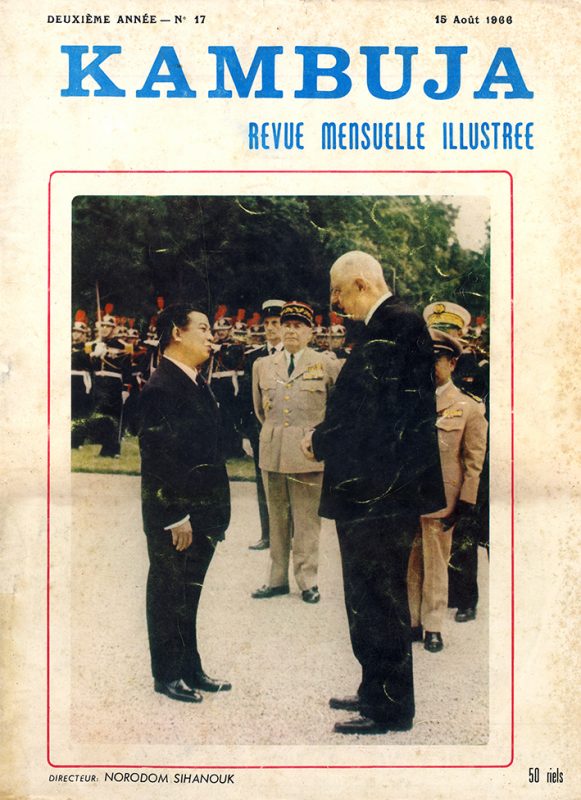
As student demonstrations and other protests against the regime escalated in 1967 and ’68, violence against those opposed to the regime intensified. School teachers would recall colleagues arrested without charge while others fled or were killed. “In Kampot in 1969, several alleged dissidents were thrown alive off a high cliff; their heads were later displayed in the Kampot market,” writes historian David Chandler.
There was also violent repression of farmers protesting exploitation by local officials in Battambang province’s Samlot district in 1967, and of Ratanakkiri province hilltribes opposing land grabbing in 1968.
Prince Sihanouk took the Samlot uprising as a personal insult and, claiming left-wing and U.S. involvement in the events, said of those who had fled to the forest in Battambang province: “There is no need to send [rebels] to a military court. Whenever we laid hands on them, we shot them immediately.”
Even with his grip on all parts of society, such events started to change the public face of the regime and by 1970 a parliamentary vote ousted Prince Sihanouk from power. He would then move to Beijing and ally himself with his previous left-wing enemies backed by Vietnam: the Khmer Rouge.
[dropcap]Y[/dropcap]et it is the powerful creative wind that blew through Cambodia under Prince Sihanouk that seems to dominate the collective memory of the time. As two Cambodian scholars living abroad recently explained, the regime was “a period of creativity in an authoritarian context.”
One of the Sangkum’s most spectacular realizations—which is rapidly being erased—was urban planning and the development of a distinct architectural style. Prince Sihanouk wanted Phnom Penh to be a stunning capital with a distinctive look.
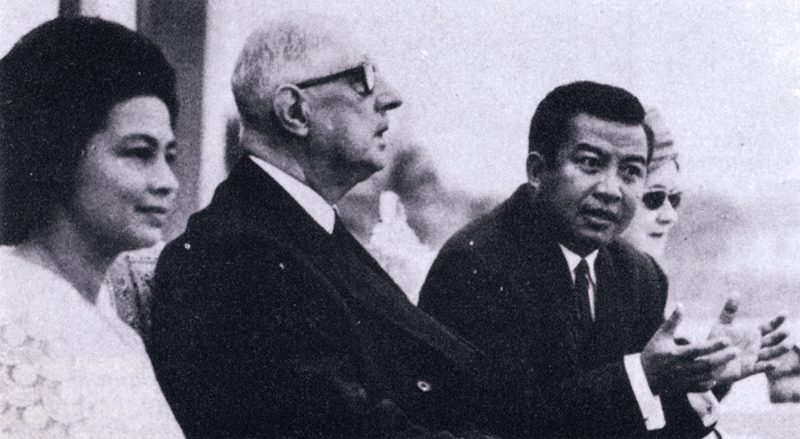
Independence from France, achieved in 1953, “was a great catalyst,” said art historian Darryl Collins, an authority on Cambodian architecture of the 1960s. “This period saw a greater youthful Cambodia emerging to meet a post-war boom.”
The era was also defined by a push to develop the education and health care systems, said historian Henri Locard.
“In health, the priority was first to combat infant mortality and then the epidemics that affected the entire population. The population at the time was—as today—very young, and about 45 percent of the population was under 14,” he said.
However, politics got in the way.
When Prince Sihanouk rejected U.S. aid in 1963 to the consternation of his economic advisors, developments in the health sector that depended on some U.S. funding were derailed. “A number of medical centers were inaugurated, and then abandoned later because of corruption or lack of resources, or both,” Mr. Locard said.
“It was in education that the achievements of the Sangkum were most spectacular and changed the mentality and aspirations of the people,” he said.
“The young learned to reject their agricultural poverty and environment,” he added. However, “too little attention was given to practical and technical education and many youths could find no employment that fulfilled their aspiration to social progress after school—to a large extent like today.”
[dropcap]W[/dropcap]ith the country ruled by one man who would make decisions on a whim, projects would at times defy logic and prove costly. For instance the Takeo-Kampot University located in the countryside had a Faculty of Oceanography even though it was located 50 km from the sea, writes the late Charles Meyer, a political advisor to Prince Sihanouk during the 1960s.
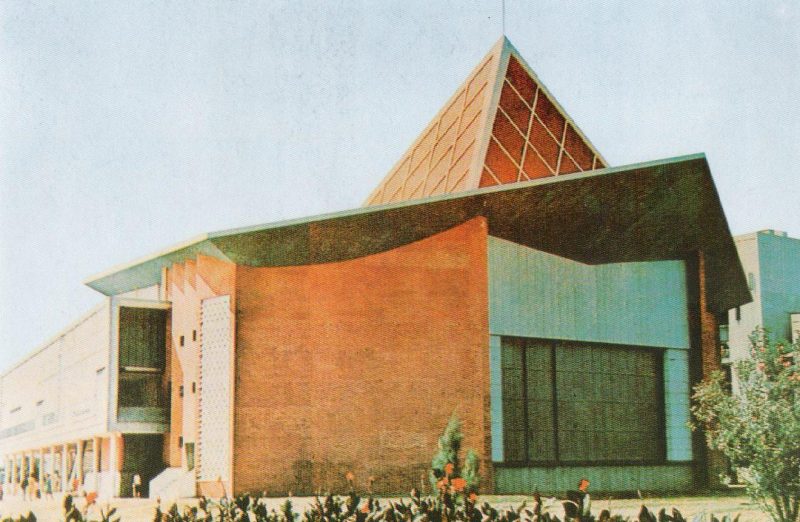
Such mismanagement combined with unbridled corruption would lead the country to a critical budget deficit. The gross domestic product, which had grown 2.5 percent annually in the early 1960s, dropped below zero in 1965, Meyer writes, and the budget deficit would continue rising through the decade. One solution devised by Prince Sihanouk was to open a casino in Phnom Penh to generate government funds, a ploy that failed.
Corruption was an ever present, if not always obvious, drag on the economy. “In the first years following the return to independence [in the early 1950s] corruption had been ‘reasonable,’” Meyer writes in his book “Derriere le sourire khmer,” or “Behind the Khmer Smile.”
“Ministers and national department heads restricted their ambition to the construction of a personal villa or the purchase of a car. But the more you have, the more you want, and this was taken on by all government staff with a modicum of authority, from the simple soldier on. Corruption turned into an institution.”
One attempt had been made in 1956 to address what was already a critical issue when Prince Sisowath Monireth was assigned to tackle the problem, Meyer writes. But his proposals to curb graft caused such uproar in the cabinet that ministers and high-ranking officials demanded his resignation. In the following years, only the occasional police officer or clerk would be punished for corruption.
And so it would continue when the power of Mr. Hun Sen and fellow CPP leaders became entrenched in the 1990s, initially as governing partners with the royalist Funcinpec party. Sam Rainsy, the plucky young finance minister, launched his own short-lived campaign against corruption before being ousted in 1994 and beginning his career in opposition politics. In the ensuing decades, major corruption cases have been few and far between—and they never touch the ruling elite.
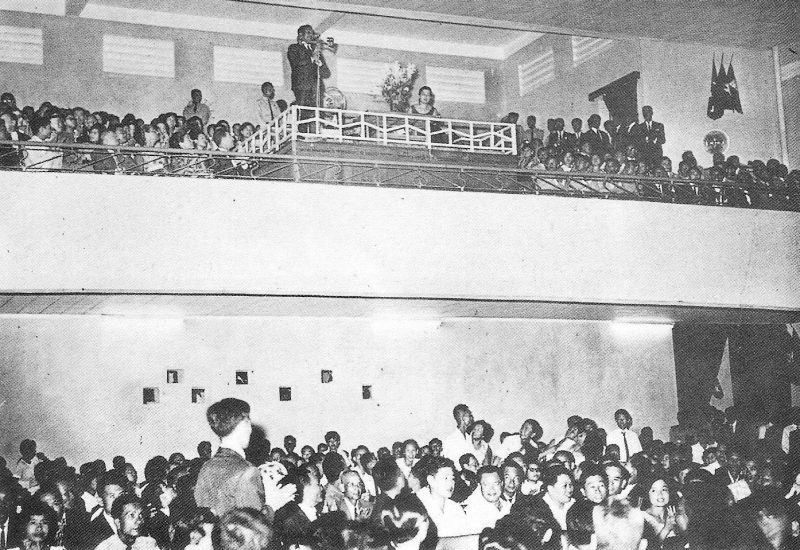
And as with Mr. Hun Sen today, Prince Sihanouk played a delicate balancing act, but always made sure he had a friend in China. By 1969, having received funding for years from Beijing in exchange for supplies being taken to North Vietnamese communist bases along the border, the prince renewed relations with the U.S., which was at war with North Vietnam, and authorized bombing in zones of low population along the border.
With the economic situation deteriorating and discontent growing, he chose to leave the country in January 1970, bringing with him what witnesses described as unusually extensive luggage. Refusing to receive his ministers or return to Phnom Penh, he was removed as head of state by parliamentary vote in March 1970. Accepting Beijing’s hospitality and financial support, he would ally himself with the very communist guerillas he had once tried to crush.
[dropcap]A[/dropcap]lmost half a century later, Cambodia is again struggling to find its place in a shifting world order as efforts to forge a progressive path forward collide with deep-rooted power structures. Much has changed, of course. Under King Sihamoni, the palace is no longer a setting for political compromise or moral guidance, but operates as a staunchly ceremonial institution.
The legacy of Prince Sihanouk lives on—not only as a reminder of the country’s potential for ingenuity and innovation. Power continues to remain firmly in the hands of one man, whose political network is inextricably entwined with the state, and who shows little tolerance for opposition forces that he perceives as threatening his control of the country.
In the 1960s as well as today, two of the scholars say, Cambodia’s familial clan system forms the underpinning of politics and the economy, with people in positions of power providing their families and friends with jobs and financial opportunities to the detriment of others.
Om Yentieng, chairman of the Anti-Corruption Unit, offered a blatant example of the custom continuing at the highest levels of government earlier this year when he appointed his two sons as his assistants in April. CPP spokesman Sok Eysan said it was only natural for the ruling party to promote the children of its own members.
Various members of Prime Minister Hun Sen’s family and inner circle have faced criminal accusations—ranging from drug trafficking to organizing assassinations to involvement in land-grabbing and the illicit timber trade—but police and the courts have generally remained disinterested in the claims.
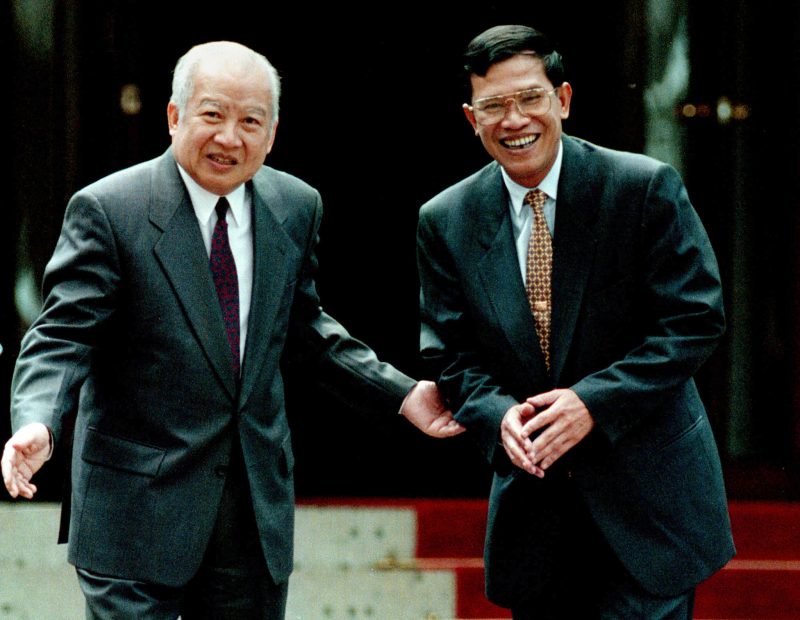
“Meant to protect and promote the clan, no matter the wrongdoing committed, the clan shields from falling under the law. A member of the clan will always be protected, no matter the transgression committed,” political scientist Raoul Marc Jennar writes in his book “Trente ans depuis Pol Pot, Le Cambodge de 1979 a 2009,” or “Thirty Years Since Pol Pot: Cambodia From 1979 to 2009”
For the CPP, which began setting up its family and business networks in the 1980s, holding on to power in next year’s commune election and the 2018 national election will be both about politics and protecting a very profitable system of influence and revenues for their clans. If events this month are any indication—Mr. Hun Sen has put a blanket ban on demonstrations against his government and the military has promised to enforce it—the ruling party is worried.
In the 1960s, the entrenched practice of hiring and promoting one’s own contributed to much of the population—including thousands of qualified Cambodians with university diplomas—turning against the regime.
“One-man, one-party rule is intellectually unhealthy, usually brutal and almost always unresponsive even to helpful criticism,” Mr. Chandler, the historian, said in interview.
“Prince Sihanouk genuinely loved the Cambodian people and felt he had been made to rule over them benignly. Hun Sen is unsentimental but seems to think that Prince Sihanouk’s style of rule—gifts, suppression, adulation, etc.—can be replicated with a much less passive population. Sihanouk was a narcissist who was overcome by situations he could not control. Hun Sen believes himself above the law and impregnable but his alliances may be less secure than he would like,” Mr. Chandler said.
Wishing to deal directly with the public, Mr. Hun Sen has long used nationally broadcast speeches to deliver directives, announce government policy, or praise and shame his subordinates. More recently, he has shown a preference for Facebook as a public forum, posting about his every activity as it is happening, whether a round of golf or meetings with other world leaders.
In the 1960s, Prince Sihanouk used the radio to reach the masses, writes historian Alain Forest.
“He established himself as a permanent presence among those populations and literally ‘enthralled’ them with long speeches, in the course of nearly non-stop and direct broadcast, of his every action or in long and terrible sessions during which his enemies were reviled,” he writes in the book “Histoire religieuse du Cambodge,” or “Cambodia’s Religious History.”
“A big difference between Sihanouk and Hun Sen is that Sihanouk did not question his future fortunes. Hun Sen prepares for all eventualities and accumulates his fortune for his future,” said Astrid Noren-Nilsson, the author of “Cambodia’s Second Kingdom.”
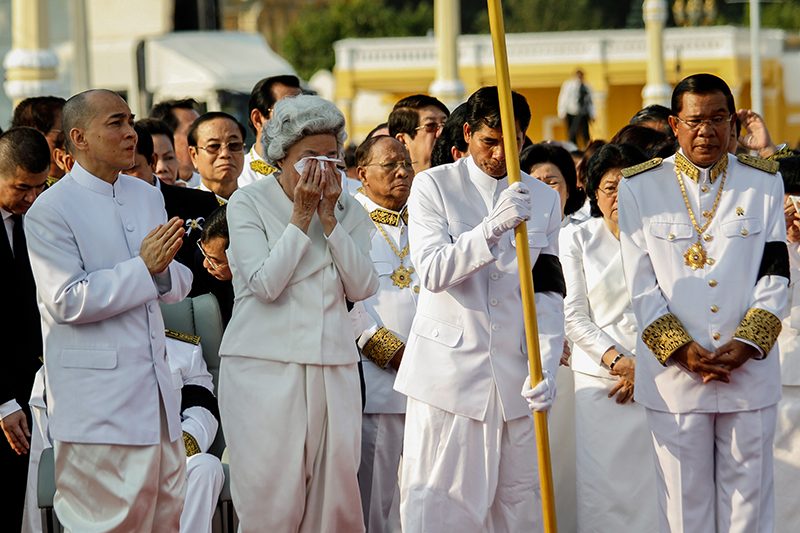
Prince Sihanouk, according to Ms. Noren-Nilsson, had about $13,000 in the bank when he died. According to a Global Witness’ report published in July, Mr. Hun Sen’s family has shares in more than 100 companies with a combined capital exceeding $200 million, which the NGO calls the “tip of the iceberg” when it comes to the ruling family’s fortunes.
[dropcap]M[/dropcap]r. Hun Sen is, in more ways than one, a moderate compared to Prince Sihanouk—although recent developments, such as efforts to jail opposition leaders and the assassination of popular political critic Kem Ley, have sent a chill through sections of society that might be viewed as CPP enemies.
In contrast to the Sangkum era, there is relative freedom of the press in modern-day Cambodia, with harsh criticism of the government tolerated in the press and over the radio, though the ruling party maintains a stranglehold on television.
And there is a strong opposition party, although it is increasingly under attack. Kem Sokha, the deputy opposition leader, has been hiding out in the party’s Phnom Penh headquarters for months, and was sentenced on September 9 to five months in jail for refusing to appear in court over a “prostitution” case that has been widely condemned as a political attack through the courts. As has often been the case over the years, Mr. Rainsy, the opposition leader, is again living in Paris to avoid a two-year prison sentence, this time for defaming former Foreign Affairs Minister Hor Namhong.
Mr. Hun Sen has been willing to tolerate open dissent and even mass movements against his regime, observers have noted, until he is not. Operating a sort of pressure valve for those opposed to his regime, he can quickly close the space for those who wish to undermine his power or disrupt the carefully maintained networks that keep him on top.
“[Mr.] Hun Sen does not exercise power as Chinese or Vietnamese leaders do, by virtue of the offices they hold within their respective parties, but because of his position at the apex of a vast patronage network,” Australian historian Martin Stuart-Fox writes in the essay “Sihanouk’s Legacy” published in 2013.
“Hun Sen will not be deposed by a vote at a CPP congress. The only way he could lose power is through the erosion of client loyalty and their ultimate defection to alternative patrons—just as happened to Sihanouk,” he writes.
“Like the monarchy (or North Korea), Hun Sen reportedly wants his position to become hereditary, to be handed on to one of his sons. This makes even more evident the extent to which Hun Sen has taken Sihanouk and the Sangkum as his political paradigms. Sihanouk’s lasting legacy, one can only conclude, has been the system of government Cambodia currently enjoys.”




